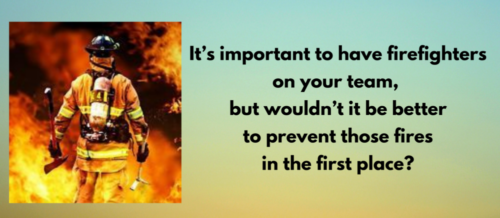
Do you remember a time when an unexpected emergency took place, and you rallied the team to get through the crisis? We all have “war stories” to share. Overcoming adversity is something we take pride in. And don’t we usually value those leaders and employees who have the ability to effectively “put out fires?”
The need to “put out fires” every day is a common complaint I hear from leaders. Similar to the impact of interruptions, putting out fires takes time away from a leader’s ability to work on more important activities. But unlike handling interruptions, leaders seem to take pride in their ability to handle a crisis. Executives put a lot of value in those who stand tall, take action, and solve problems. We all love a good firefighter.
But do you ever stop to think about why those fires occurred? Why do we spend so much time fighting fires, and so little time trying to prevent them?
Back in my Navy days, I attended a three-week advanced firefighting school. It was hot (600 degrees), dirty, and slightly dangerous (I got a 2nd degree burn). But it was also fun and exciting, and since that time I’ve always wanted to be a volunteer firefighter. Conversely, walking through my home looking for fire hazards is not fun, but much more important.
The same view should be taken in your organization. Putting out fires is an important skill, but more important to your organization is the leader who aggressively prevents fires. At the root of most crises is a poor process. Equipment downtime, material shortages, and employee errors are all process issues. It’s not as sexy as firefighting, but the leader who continuously searches for the root causes of problems, and strives to correct them, is much more valuable to your organization.
I once had a supervisor who was phenomenal at meeting deadlines and overcoming obstacles. I never had to worry about his area of responsibility, which allowed me to focus on other problems. The flip side was that we never got better, and that was my fault because I was content with the status quo. He was so good at going over, around, and through obstacles, that we never tried to remove the obstacles.
For any organization to succeed, it must regularly improve. Stagnate organizations eventually fail. It is imperative for leaders to proactively seek ways to improve processes and prevent fires, regardless of difficulty or time availability. And executives must put more value in those leaders who demonstrate their commitment to process improvement. It’s important to have firefighters on your team, but wouldn’t it be better to prevent those fires in the first place?
Previously published in Virginia Business Front Magazine

